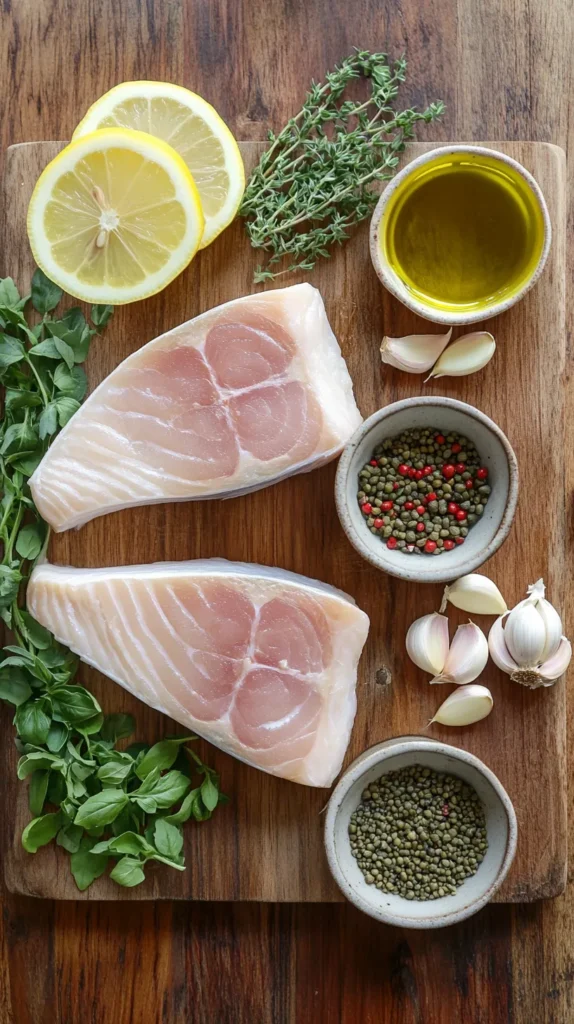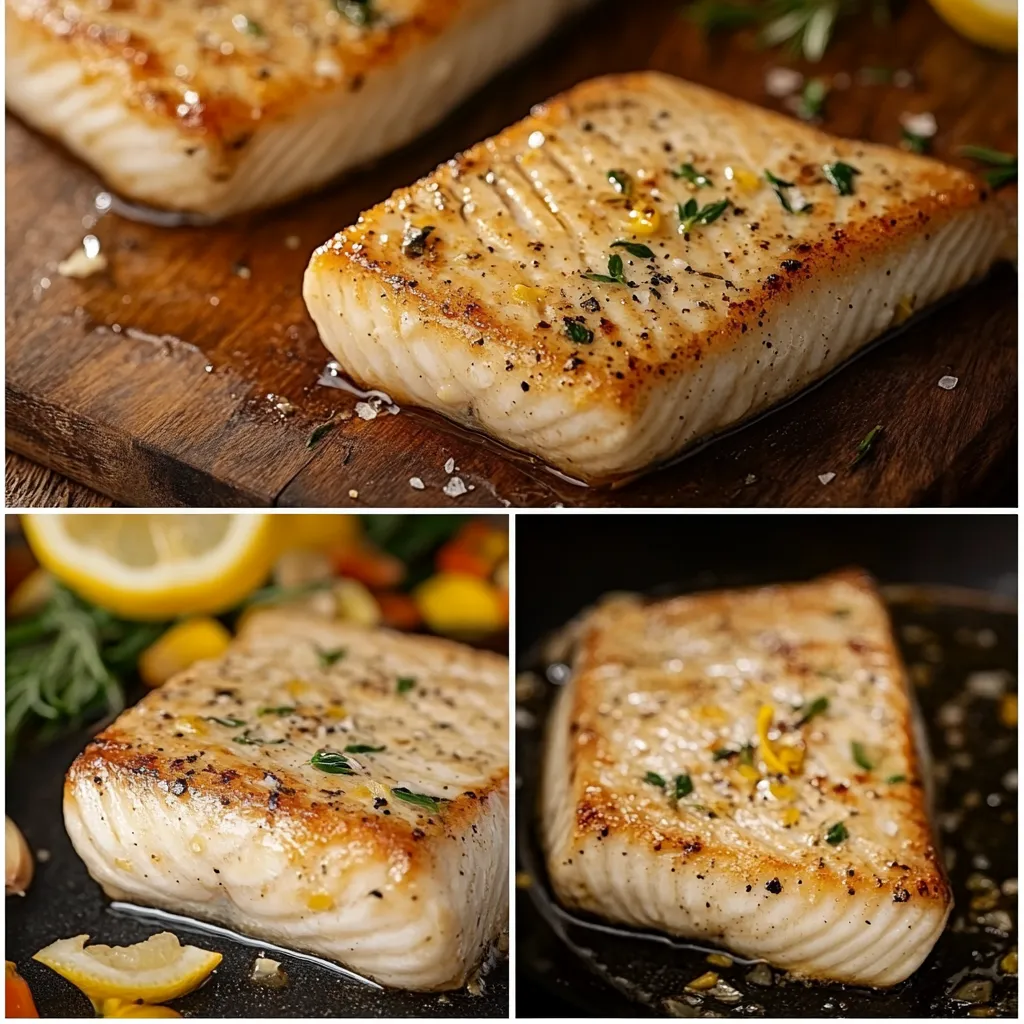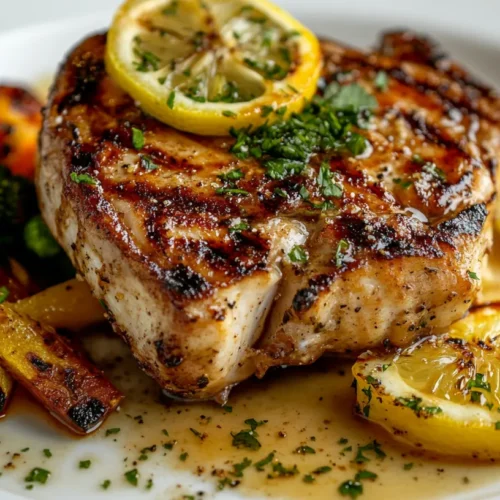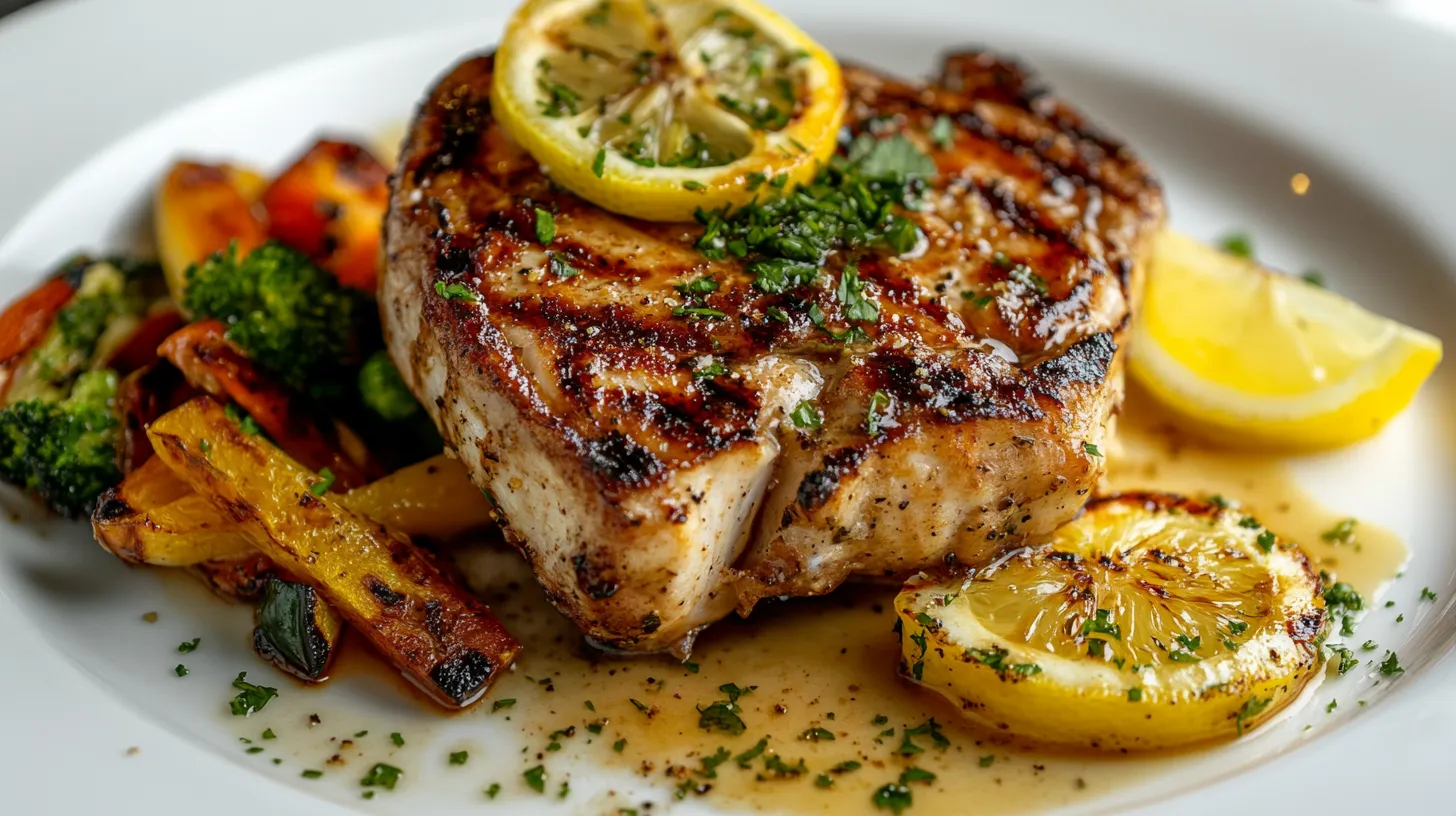Introduction
Swordfish, often dubbed the “steak of the sea,” is a culinary delight cherished for its firm texture and mildly sweet flavor. This robust fish stands up well to various cooking methods, making it a versatile choice for both casual dinners and special occasions.
One of the standout features of swordfish is its dense, meaty texture, which closely resembles that of beef steak. This unique characteristic allows it to be grilled, seared, or baked without falling apart, offering a satisfying bite that’s both hearty and tender. The flesh ranges in color from white to pinkish hues, all turning a delectable beige upon cooking.
Flavor-wise, swordfish boasts a mildly sweet taste with a moist, succulent mouthfeel. Its moderate fat content contributes to its rich flavor, making it a favorite among seafood enthusiasts. This subtle sweetness pairs exceptionally well with a variety of seasonings and marinades, particularly those featuring citrus, garlic, and fresh herbs.
Incorporating swordfish into your culinary repertoire not only diversifies your meal options but also offers nutritional benefits. It’s a rich source of high-quality protein, omega-3 fatty acids, and essential vitamins and minerals, contributing to a balanced and health-conscious diet.
Whether you’re a seasoned home cook or a culinary novice, exploring swordfish recipes can elevate your cooking game. Its adaptability to different flavors and cooking techniques ensures that you can create dishes that are both impressive and delectable.
In this guide, we’ll delve into a swordfish recipe that promises to tantalize your taste buds and become a staple in your kitchen. From understanding its key benefits to mastering the cooking process, you’ll be well-equipped to prepare a swordfish dish that truly blows your mind.
Table of Contents
Key Benefits of Cooking Swordfish
Swordfish is a popular choice for seafood lovers because of its meaty texture, mild flavor, and versatility. Whether grilled, baked, or pan-seared, it delivers a satisfying bite and absorbs seasonings beautifully. Here’s why this swordfish recipe is worth trying:
1. Firm, Steak-Like Texture
Swordfish has a dense, hearty texture that holds up well to high-heat cooking methods. Unlike flakier white fish, it stays firm, making it perfect for grilling, searing, or roasting.
2. Mild Flavor That Pairs Well with Seasonings
This fish has a subtle sweetness that allows it to pair well with bold seasonings like garlic, lemon, herbs, and spices. It soaks up marinades without being overpowered, making it an excellent base for different flavors.
3. Quick and Easy to Cook
Swordfish cooks in minutes, making it a great option for busy weeknights. Whether you’re grilling, pan-searing, or baking, it takes just 10 to 15 minutes to prepare a flavorful, satisfying dish.
4. Nutrient-Dense and Protein-Packed
Swordfish is an excellent source of lean protein while also providing omega-3 fatty acids, which support heart health. It’s also rich in vitamins B12, D, and essential minerals like selenium.
5. Holds Up to Different Cooking Methods
Unlike delicate fish that fall apart, swordfish remains intact when grilled, pan-seared, or baked. It also retains moisture well, ensuring a juicy bite when cooked properly.
6. Great for a Variety of Side Dishes
Swordfish pairs well with light, refreshing sides like grilled vegetables, salads, or roasted potatoes. Its versatility makes it a great addition to a Mediterranean, Asian, or classic American-style meal.
7. Restaurant-Quality Meal at Home
With its rich, buttery texture, swordfish feels elegant and gourmet, making it a great option for home cooks who want to create a high-end dining experience without the hassle.
Ingredients
This swordfish recipe uses simple, fresh ingredients to enhance its natural flavors without overpowering the fish. The combination of lemon, garlic, and olive oil creates a balanced and delicious dish that’s easy to prepare.

Main Ingredients:
- Swordfish steaks – Fresh or frozen, about 1 to 1½ inches thick. Choose steaks that are firm, moist, and free from strong odors.
- Olive oil – Extra virgin olive oil for richness and moisture. It helps prevent the fish from drying out.
- Fresh lemon juice – Adds bright acidity and enhances the natural flavors of the fish.
- Garlic cloves – Minced garlic provides a deep, aromatic taste that complements the mild sweetness of swordfish.
- Kosher salt – Enhances the natural flavors without overpowering the dish.
- Black pepper – Adds warmth and depth to the seasoning.
- Capers – For a briny, slightly tangy contrast that pairs well with the richness of the fish.
- Red pepper flakes (optional) – Adds a mild heat for those who enjoy a little spice.
- Fresh herbs – Parsley, thyme, or rosemary work well for garnish and extra flavor.
Optional Ingredients for More Flavor:
- Lemon zest – A hint of zest can make the lemon flavor even more pronounced.
- Garlic butter – A mix of melted butter and garlic can be drizzled over the top for a richer finish.
Why These Ingredients Work:
- Lemon juice and garlic help balance the richness of swordfish, making it bright and flavorful.
- Olive oil and herbs add depth and moisture, ensuring the fish doesn’t dry out.
- Capers and red pepper flakes bring bold contrast, giving the dish a bit of complexity.
How to Make Swordfish Recipe
Cooking swordfish is simple and quick, but the key is to use the right technique to keep it moist, flavorful, and perfectly cooked. Below, you’ll find a step-by-step guide for grilling, pan-searing, and baking swordfish.

Step 1: Prepare the Swordfish Steaks
- Pat the swordfish steaks dry with paper towels to remove excess moisture.
- Season both sides with kosher salt, black pepper, and red pepper flakes (if using).
- In a small bowl, mix together the olive oil, fresh lemon juice, minced garlic, and capers. This will act as both a marinade and a finishing sauce.
Step 2: Marinate for Maximum Flavor (Optional but Recommended)
- Place the seasoned swordfish steaks in a shallow dish or zip-top bag.
- Pour the lemon-garlic marinade over the fish, making sure both sides are coated.
- Let the fish marinate for 15-30 minutes at room temperature. Do not marinate for too long, as the acid in the lemon juice can start to “cook” the fish.
Step 3: Choose Your Cooking Method
Option 1: Grilling Swordfish (Best for Charred Flavor)
- Preheat the grill to medium-high heat (around 400-450°F). Lightly oil the grates to prevent sticking.
- Place the swordfish steaks on the grill and cook for 3-4 minutes per side until grill marks appear.
- Flip once and cook for another 3-4 minutes until the fish is opaque and flakes easily.
- Remove from heat and let it rest for a few minutes before serving.
Pro Tip: Use a meat thermometer to check for doneness. Swordfish is fully cooked when the internal temperature reaches 130-135°F (it will continue cooking as it rests).
Option 2: Pan-Searing Swordfish (Best for a Golden Crust)
- Heat a cast-iron skillet or heavy-bottomed pan over medium-high heat. Add 1-2 tablespoons of olive oil.
- Once hot, add the swordfish steaks and sear for 3-4 minutes on the first side without moving them.
- Flip the fish and cook for another 3-4 minutes until golden brown and cooked through.
- Remove from heat and let the fish rest for 2-3 minutes before serving.
Pro Tip: Add 1 tablespoon of butter and minced garlic during the last minute of cooking for extra flavor.
Option 3: Baking Swordfish (Best for a Hands-Off Approach)
- Preheat the oven to 400°F (200°C).
- Place the swordfish steaks in a lightly greased baking dish.
- Drizzle the lemon-garlic marinade over the fish.
- Bake for 12-15 minutes until the fish is opaque and flakes easily with a fork.
- Remove from the oven and let it rest for a couple of minutes before serving.
Pro Tip: If you want a golden crust, broil the fish for the last 2 minutes.
Step 4: Serve and Garnish
- Drizzle any remaining marinade or garlic butter sauce over the top.
- Sprinkle with fresh chopped parsley or rosemary for extra flavor.
- Serve with lemon wedges on the side for a burst of brightness.
Pro Tips and Variations
Cooking swordfish is simple, but getting it just right requires a few expert tricks. Follow these pro tips to ensure your swordfish turns out juicy, flavorful, and perfectly cooked every time. Plus, explore some delicious variations to customize the recipe to your taste.
Pro Tips for Cooking Perfect Swordfish
1. Don’t Overcook It
Swordfish is best when it’s cooked to an internal temperature of 130-135°F and then allowed to rest for a few minutes. Overcooking can make it dry and tough, so use a meat thermometer for the best results.
2. Marinate for Extra Flavor, But Not Too Long
While swordfish absorbs marinades well, too much acid (like lemon juice) can start breaking down the texture. Keep marinating time between 15-30 minutes to enhance the flavor without affecting the fish’s structure.
3. Pat the Fish Dry Before Cooking
For a beautiful golden crust, always pat swordfish dry with paper towels before seasoning and cooking. This prevents steaming and allows for a nice sear.
4. Let It Rest Before Serving
After cooking, let the fish rest for 2-3 minutes. This allows the juices to settle evenly, ensuring the fish stays juicy and tender.
5. Use a Cast-Iron Pan for the Best Sear
For pan-searing, a cast-iron skillet works best. It retains heat well, giving the swordfish a perfect crispy crust without overcooking the inside.
Flavor Variations to Try
Looking to change things up? Here are different seasoning blends and sauces to customize your swordfish:
1. Mediterranean Style
- Marinade: Olive oil, lemon juice, garlic, capers, and fresh oregano
- Serving Idea: Serve with a Greek salad and roasted vegetables
2. Cajun Spiced Swordfish
- Seasoning: Paprika, cayenne, garlic powder, onion powder, thyme, and black pepper
- Cooking Tip: Pan-sear in butter for a smoky, spicy crust
3. Garlic Butter Swordfish
- Sauce: Melted butter, garlic, fresh parsley, and a squeeze of lemon
- Serving Idea: Pair with garlic mashed potatoes or sautéed green beans
4. Asian-Inspired Swordfish
- Marinade: Soy sauce, sesame oil, ginger, honey, and lime juice
- Serving Idea: Serve with steamed rice and stir-fried vegetables
5. Spicy Lime Swordfish
- Seasoning: Chili powder, lime zest, cumin, and smoked paprika
- Serving Idea: Pair with grilled corn and avocado salsa
Serving Suggestions
Swordfish pairs well with a variety of side dishes, allowing you to create a balanced, flavorful meal. Whether you prefer something light and refreshing or hearty and comforting, here are some of the best sides to serve with swordfish.
1. Fresh and Light Side Dishes
If you want to keep the meal light and refreshing, these sides will complement the richness of swordfish without overpowering it:
- Grilled Vegetables – Asparagus, zucchini, bell peppers, and eggplant bring smoky, charred flavors that enhance the dish.
- Mediterranean Salad – A mix of cherry tomatoes, cucumbers, red onion, feta cheese, and olives, tossed in a light vinaigrette, adds a fresh contrast.
- Lemon Herb Quinoa – A protein-packed alternative to rice with bright citrus notes.
- Garlic Roasted Green Beans – Crisp, tender green beans with a hint of buttery garlic flavor.
- Cucumber Avocado Salad – A cool, creamy salad that balances the bold flavors of the fish.
2. Hearty and Comforting Side Dishes
For a more filling meal, try pairing swordfish with these hearty, satisfying sides:
- Garlic Butter Mashed Potatoes – Creamy mashed potatoes soak up the lemon-garlic sauce beautifully.
- Herb-Roasted Potatoes – Crispy, golden-brown potatoes seasoned with rosemary and thyme add a satisfying crunch.
- Wild Rice Pilaf – A nutty, slightly chewy side that pairs well with the meaty texture of swordfish.
- Creamy Parmesan Risotto – A rich, velvety dish that enhances the mild sweetness of the fish.
- Corn on the Cob with Chili Lime Butter – The smoky-sweet flavor of grilled corn pairs perfectly with zesty swordfish.
3. Sauces and Garnishes for Extra Flavor
If you want to elevate your swordfish dish, try drizzling one of these sauces on top:
- Lemon Garlic Butter Sauce – A simple mix of melted butter, lemon juice, and garlic for a rich, tangy finish.
- Mango Salsa – Sweet and spicy mango, red onion, cilantro, and lime add a tropical touch.
- Caper Herb Sauce – A briny, herby topping made with capers, parsley, and olive oil.
- Spicy Cilantro Chimichurri – A bold, herbaceous sauce with a hint of heat and acidity.
- Tzatziki Sauce – A creamy Greek yogurt-based sauce with cucumber and dill for a cool contrast.
Best Drinks to Pair with Swordfish
Complete the meal with a perfectly matched drink:
- White Wine – A crisp Sauvignon Blanc or Chardonnay enhances the dish’s lemon-garlic notes.
- Citrus-Infused Sparkling Water – A refreshing, non-alcoholic option that cleanses the palate.
- Light Beer – A pale ale or wheat beer provides a mild, malty balance to swordfish’s richness.
Conclusion
Swordfish is a versatile, flavorful, and easy-to-cook fish that can transform any meal into a restaurant-quality experience. Whether you choose to grill, pan-sear, or bake, this recipe ensures a juicy, well-seasoned swordfish steak that pairs beautifully with a variety of side dishes.
By following the pro tips in this guide, you’ll be able to achieve the perfect texture and flavor every time. Remember to:
✔ Avoid overcooking to keep the fish moist and tender.
✔ Use fresh, high-quality ingredients like lemon juice, garlic, and olive oil for the best flavor.
✔ Experiment with different seasonings and marinades to suit your taste.
With its firm texture and mild sweetness, swordfish is an excellent choice for seafood lovers looking to try something different. Whether you serve it with a simple salad, roasted vegetables, or a rich garlic butter sauce, this dish is sure to impress.
Now that you know exactly how to cook swordfish, it’s time to head to the kitchen and try it for yourself. Enjoy your meal!

swordfish recipe
Ingredients
Main Ingredients:
- Swordfish steaks – Fresh or frozen about 1 to 1½ inches thick. Choose steaks that are firm, moist, and free from strong odors.
- Olive oil – Extra virgin olive oil for richness and moisture. It helps prevent the fish from drying out.
- Fresh lemon juice – Adds bright acidity and enhances the natural flavors of the fish.
- Garlic cloves – Minced garlic provides a deep aromatic taste that complements the mild sweetness of swordfish.
- Kosher salt – Enhances the natural flavors without overpowering the dish.
- Black pepper – Adds warmth and depth to the seasoning.
- Capers – For a briny slightly tangy contrast that pairs well with the richness of the fish.
- Red pepper flakes optional – Adds a mild heat for those who enjoy a little spice.
- Fresh herbs – Parsley thyme, or rosemary work well for garnish and extra flavor.
Optional Ingredients for More Flavor:
- Lemon zest – A hint of zest can make the lemon flavor even more pronounced.
- Garlic butter – A mix of melted butter and garlic can be drizzled over the top for a richer finish.
Instructions
Step 1: Prepare the Swordfish Steaks
- Pat the swordfish steaks dry with paper towels to remove excess moisture.
- Season both sides with kosher salt, black pepper, and red pepper flakes (if using).
- In a small bowl, mix together the olive oil, fresh lemon juice, minced garlic, and capers. This will act as both a marinade and a finishing sauce.
Step 2: Marinate for Maximum Flavor (Optional but Recommended)
- Place the seasoned swordfish steaks in a shallow dish or zip-top bag.
- Pour the lemon-garlic marinade over the fish, making sure both sides are coated.
- Let the fish marinate for 15-30 minutes at room temperature. Do not marinate for too long, as the acid in the lemon juice can start to “cook” the fish.
Step 3: Choose Your Cooking Method
- Option 1: Grilling Swordfish (Best for Charred Flavor)
- Preheat the grill to medium-high heat (around 400-450°F). Lightly oil the grates to prevent sticking.
- Place the swordfish steaks on the grill and cook for 3-4 minutes per side until grill marks appear.
- Flip once and cook for another 3-4 minutes until the fish is opaque and flakes easily.
- Remove from heat and let it rest for a few minutes before serving.
- Pro Tip: Use a meat thermometer to check for doneness. Swordfish is fully cooked when the internal temperature reaches 130-135°F (it will continue cooking as it rests).
- Option 2: Pan-Searing Swordfish (Best for a Golden Crust)
- Heat a cast-iron skillet or heavy-bottomed pan over medium-high heat. Add 1-2 tablespoons of olive oil.
- Once hot, add the swordfish steaks and sear for 3-4 minutes on the first side without moving them.
- Flip the fish and cook for another 3-4 minutes until golden brown and cooked through.
- Remove from heat and let the fish rest for 2-3 minutes before serving.
- Pro Tip: Add 1 tablespoon of butter and minced garlic during the last minute of cooking for extra flavor.
- Option 3: Baking Swordfish (Best for a Hands-Off Approach)
- Preheat the oven to 400°F (200°C).
- Place the swordfish steaks in a lightly greased baking dish.
- Drizzle the lemon-garlic marinade over the fish.
- Bake for 12-15 minutes until the fish is opaque and flakes easily with a fork.
- Remove from the oven and let it rest for a couple of minutes before serving.
- Pro Tip: If you want a golden crust, broil the fish for the last 2 minutes.
Step 4: Serve and Garnish
- Drizzle any remaining marinade or garlic butter sauce over the top.
- Sprinkle with fresh chopped parsley or rosemary for extra flavor.
- Serve with lemon wedges on the side for a burst of brightness.
Notes
Nutrition Information (Per Serving)
- Calories: 350
- Protein: 40g
- Fat: 18g
- Carbohydrates: 3g
- Saturated Fat: 3g
- Cholesterol: 95mg
- Sodium: 420mg
- Fiber: 0.5g
- Sugar: 1g
- Omega-3 Fatty Acids: High
FAQs
1. What is the best method of cooking swordfish?
The best way to cook swordfish depends on the texture and flavor you prefer. Grilling and pan-searing are the top choices because they create a beautiful crust while keeping the fish juicy. Baking is a great hands-off method, while broiling adds a nice charred finish. For the best results, cook swordfish over medium-high heat and avoid overcooking to maintain its tenderness.
2. What should I season swordfish with?
Swordfish has a mild flavor, so it pairs well with bright and bold seasonings. A simple blend of kosher salt, black pepper, fresh lemon juice, garlic, and olive oil works well. You can also add capers, fresh herbs like parsley or thyme, or red pepper flakes for extra depth. For a richer taste, drizzle it with garlic butter sauce after cooking.
3. What seasoning is best for swordfish?
The best seasoning depends on the flavor profile you want:
Classic Mediterranean: Olive oil, lemon juice, garlic, oregano, and capers.
Spicy Cajun: Paprika, cayenne, garlic powder, onion powder, and thyme.
Garlic Herb Butter: Melted butter, garlic, parsley, and a squeeze of lemon.
Asian-Inspired: Soy sauce, sesame oil, ginger, and a touch of honey.
4. Is swordfish a good fish to eat?
Yes! Swordfish is nutrient-rich and high in protein while also being a great source of omega-3 fatty acids, vitamin B12, and selenium. It has a firm, meaty texture that makes it satisfying and easy to cook. However, because swordfish is a larger predatory fish, it contains moderate levels of mercury, so it’s best enjoyed in moderation (about once a week for most adults).

